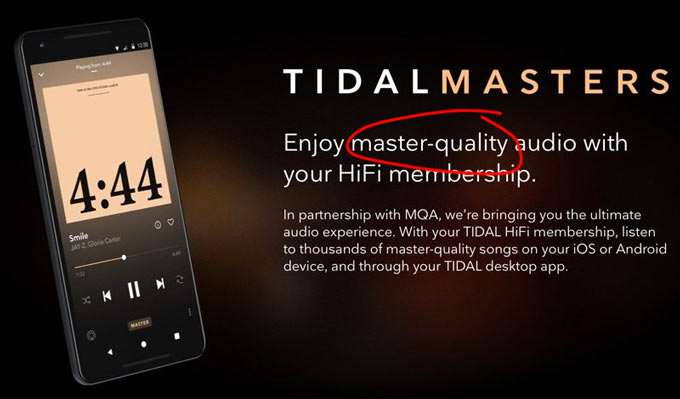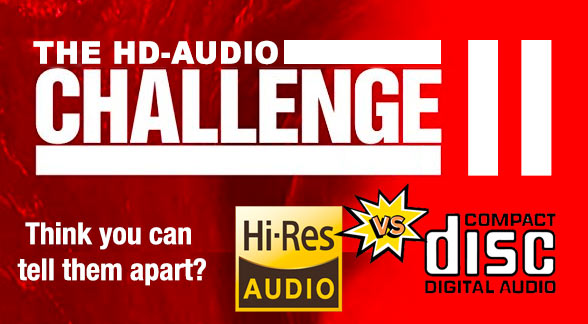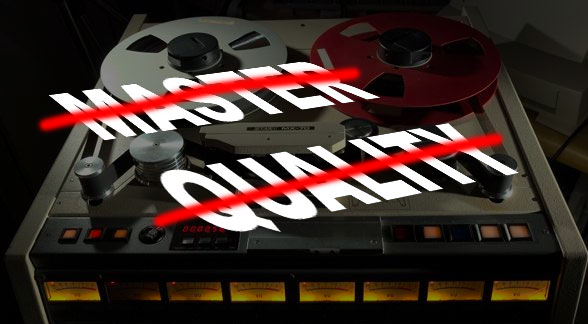Welcome to 2020: A New Decade for Audio Masters
“Master Quality” was the topic in a recent article written by my friend Steven Stone at Audiophile Review. His piece titled, “What Does Master Quality Mean to Me (or You)?” prompted a lively discussion and a lengthy post by the inventor of the MQA (Master Quality Authenticated) Bob Stuart. Steven asks what does “master quality” mean and who makes the judgement about what is and what isn’t master quality. Feel free to read the article.

What follows is a lengthy comment by Bob Stuart, which includes footnotes to some of his articles. As I have written previously, Bob has attempted to redefine the meaning of high-resolution (read “Hi-Res Audio HAS Specifications”) away from hard and fast specifications into the realm of subjective experience. His argument is decidedly biased and avoids the real world facts associated with hi-res audio and hi-res music.
I had to respond to his comment:
A short comment from Bob? There are more words in his comment than in the original article!
Steven, as you know I’ve made my living as an audio engineer, record producer, university professor, and label owner for over 40 years. During that time, I’ve worked extensively with analog tape (stereo and multichannel – I owned a 3M 56 2″ 16-track tape machine and still have my Nagra and Ampex 440-C), early standard-resolution PCM digital, and high-resolution PCM digital. I was one of the first to record, mix, and release true high-resolution native recordings when DVD-Audio was introduced in 2000. As many in the industry still refuse to properly address the issue of provenance (standard-resolution analog recording derived from tape can never be classified as hi-res music because the original recording formats weren’t capable of hi-res capture), it’s important to be consistent and accurate when discussing the issue of “masters” in regards to hi-res audio.
In actuality, there can be several — or even many — “masters” in the production and release of a music album. Like you Steven, I’ve recorded hundreds of live musical events directly to 2-channel stereo (analog or digital), duped them onto cassettes or burned CD-Rs and called it day. When I worked with the pop band Ambrosia in the late 70s and early 80s at Mama Jo’s studios, we recorded to a Stephens 2″ 24-track tape machine. The 2″ tapes that resulted from those sessions were rightfully called the “multitrack masters”. They were supposed to be delivered to the labels along with at least two other “masters” – the stereo mixdown and ultimately the final mastered “gold master”. The very be consumers could hope for during analog era were vinyl LPs or cassettes — and the were 3rd or 4th generation from the “multitrack master”.
I was fortunate enough to be a participant in sessions held at Battery Studios in New York City some years ago. According to the engineers working on new restorations and digitizations for streaming and disc release, they rarely have access to the final mastered “master”. When preparing a “so-called” hi-res music version of an album from the classic analog period, they are often forced to search track by track for the “best” surviving copy of the analog master. In the case of a Harry Nilsson release they were working on, that meant using a duplication safety copy located in a German vault. My friends at the WB and Universal mastering rooms concur that the real masters are NOT typically available. The digital releases audiophile download and stream are not actually masters.
After a preliminary review of the HD-Audio Challenge submissions (which is ongoing and open to all looking to participate), no one can pick out a high-res audio track over a CD version of the same track. The high-res marketing hoax and other processes that promote getting back to the original master should be honest and recognize that any problems we have with the fidelity of classic analog era records and the new digitally produced ones are not the fault of the CD format or standard-resolution sample rate and word lengths. The failure to deliver fidelity is due primarily to poor engineering choices, inadequate equipment, analog decks that are not calibrated or capable of delivering 100% of the fidelity on a master, and the demand by labels (not artists) for ever louder releases.
The very best “masters”we can hope for are files obtained from the original 2-channel mixed master digitized at 96/24-bit PCM using state-of-the-art analog tape machines and ADCs and delivered without ANY additional processing of any kind — this includes MQA.
The following comment and questions were posted:
Peter Mrozik Mr. Waldrep makes an interesting point: “The very best “masters”we can hope for are files obtained from the original 2-channel mixed master digitized at 96/24-bit PCM using state-of-the-art analog tape machines and ADCs and delivered without ANY additional processing of any kind — this includes MQA.” Assuming this is correct, and I suspect that it is, I have a few questions:
1) If we were to compare precisely the same Title (from the same “Master”), one instance on Qobuz at 96/24, and the other instance a Master Quality Tidal recording that unfolds (sorry if this is not the precise term, Mr. Stuart and Mr. Stone) to 96/24 – would there be any perceptible difference?
2) If not, is the primary benefit of the MQA technology to shrink the bandwidth required to deliver these recordings? Would this be primarily of interest to the streaming services rather than to their subscriber base?
3) If there is a perceptible difference, to which element(s) of the MQA technology chain can we look towards to explain the difference?Thanks for the lively conversation!
Answers
- All of the so-called “hi-res” download and streaming services get their content from the record labels. With very few exceptions, the “master” that is delivered to HDtracks is exactly the same file that is provided to Qobuz or Apple Music or Amazon Music HD. There are no fidelity differences with the delivered audio files. The best version of that file is one that is not processed any further by the Digital Audio Provider. So the audio fidelity that we experience from Qobuz or Amazon Music HD is entirely dependent on the signal path of the file downloaded or streamed from the provider. Your sound card, DAC, and other components determine the ultimate fidelity you hear. When Tidal runs the masters through the MQA lossy process, streams them, and you listen using a DAC without MQA decoding, you’re getting less fidelity than the master. And if you have a DAC or streamer with the MQA decoding capability, you get a processed file that is different than the original delivered master. You may find the MQA process does something that you prefer over the original unprocessed master, but there is a difference. Whether it is perceptible is an open question. I suspect few would be able to detect any difference.
- MQA’s clever “origami” technique does reduce the bandwidth required to deliver hi-res audio files. And it does make MQA interesting to streaming services. According to the inventor, MQA is not supposed to change the fidelity of the original master. I take that to mean that the process delivers equivalent fidelity using less bandwidth. But there are other FREE options to do the same thing! And bandwidth isn’t really an issue for audiophiles any more. And finally, we may find that delivery ultrasonic frequencies (those that get folded in the origami trick MQA accomplishes) is completely unnecessary. Virtually all commercial recordings don’t have any music information above 20 kHz, our systems can’t reproduce it, and our ears can’t hear it. It’s all a hoax to generate profits for MQA, for equipment makers suckered into supporting it, and labels to resell old content again.
- The reduction from 24-bits to 17-bits — the first step in the MQA process — may alter the sound in a perceptible way. But if the process is doing what Bob Stuart told me it should be doing, there won’t be any change in the fidelity.
“Master Quality” — like the equally meaningless marketing phrase “as the artist intended” — is being used by companies and organizations to hype formats and processes that contribute nothing to the enjoyment of recorded music. It’s supposed to evoke the final listening experience the artists and engineers had when auditioning the final rundown of the master in a professional studio. The false promise is that audiophiles can get that same “master quality” experience at home if we buy into the industry’s marketing message.
What we want and should be demanding is better sounding masters in whatever format is simple, inexpensive, and ubiquitous — and that format is unadulterated 48/96 kHz/24-bit PCM digital. And thankfully, that format can be streamed, stored, and reproduced without MQA!
The Hi-Res Audio Challenge II Continues

There’s still time to participate in the HD-Audio Challenge. Please visit the following page and sign up before the survey ends. If you’ve ever wondered whether you can differentiate between a bona fide hi-res file and a CD-spec version of the same file, then this challenge is for you. So far over 600 audiophiles have asked to participate. The more people get involved the stronger the results will be. Please visit: http://www.realhd-audio.com/?p=6713


One thing I’ve never understood is why FLAC (Free Lossless Audio Codec) isn’t used for streaming. It gets approximately a 50% reduction in file size with no information thrown away. Like a zip file, FLAC looks for repeating patterns, which it uses to create a glossary at the head of the file, with a short nickname for each such pattern, which is replaced in the file by the nickname; the original patterns are then substituted back into the file in place of the nicknames as it is played back. FLAC also supports the same tags – even cover art – that mp3 supports, with the same tag editors able to work on it.
Being intentionally created for the public domain, FLAC is widely supported by music programs (like Foobar2000, Twonky, and BubbleUPnP) since there’s no charge for using it. I play FLAC files over the internet from my hard drive with no performance or fidelity hit. The only reason I can see why FLAC is not used for streaming is that there’s no company behind it for support.
FLAC is in essence, a zip file for PCM – PCM being the format used by CDs and high resolution audio of the sort used by recording studios and distributed by AIX, iTrax, HDtracks, etc. (WAV is just another name for PCM.)
Thanks Phil. PCM is the name of the process of encoding and WAV is the name of the format container.
And the FLAC process is part of the MQA process…only free.
Steven Stone posted a link to the same article inside the High Fidelity Stereo Facebook community(a relatively quiet place considering the subject matter) and it has only one comment. No pro/anti-MQA arguments(it’s there on a few earlier posts)
I am not an audiophile and would appreciate any suggestions from the audiophile community as to which DAC for listening to music via my iPhone Xs Max is best? I just signed up for a trial subscription with Amazon HD Music. I chose Amazon since they do not use the MQA process that Dr. Waldrep and others seem to question. I have read good reviews on the Dragonfly Cobalt but it uses the MQA processing. Would this interfere with the streaming from Amazon HD since they do not use MQA? Thanks everybody, especially Dr. Waldrep for his insight and GUTS in telling us how it really is when it comes to listening to good audio.
Archimago, among others, have reviewed the Cobalt and are not impressed. If you must have a Dragonfly it seems the Black is the better choice.
http://archimago.blogspot.com/2019/08/measurements-dragonflies-audioquest.html
Thank you Chooke. Are you implying that the Black does not include the MQA processing but the Cobalt does?
I just don’t want any DAC that would degrade streamed music that is not encoded with MQA, such as Amazon . If a DAC that includes MQA has NO affect on non-MQA music that is streamed, I would be interested in their product.
And while we’re at it, which portable DAC would you recommend, if any?
Thank you for your reply.
Rick